
How to Stop Google Chrome from Tracking Your Location On Itel S23? | Dr.fone

How to Stop Google Chrome from Tracking Your Location On Itel S23?
Do you know your web browser is continually sharing your actual location online? You might not have noticed, but the number of websites using your location has increased. As you are well aware of the dangers of the internet, it doesn’t make sense to turn your Chrome into a beacon for ill-intentioned people. Luckily, it is possible to fake a location on Chrome with the right tool.
Are you wondering how to fake the browser location or which tool to use? You can get all your answers by reading this article till the end.

Part 1: How Does Chrome Know Your Location?
Before discussing Google Chrome’s fake location, it is important to know how Chrome detects your physical location. Google Chrome uses many ways to pinpoint your exact location, like your IP address, GPS, Wi-Fi, Bluetooth, and Cell Tower data. Every internet connection has an IP address bound to a location that enables Chrome to identify your location.
Similarly, GPS location can easily be tracked if your phone device has it enabled. All the Wi-Fi and Bluetooth connections around you also have location information embedded in them. They can help Chrome track you as long as your device can detect them. If you use cell data, Google Chrome can also track you through cell towers.
Part 2: How to Hide Location Services in Chrome?
If you are worried about Google Chrome detecting your physical location and sharing it with websites and apps, you can hide it easily. The process of hiding your location on Google Chrome is simple, even if you are using multiple devices. Below is the step-by-step process of hiding location services in Google Chrome on computer, Android, and iOS devices.
Method 1: For Laptop and Desktop PCs
Step 1: Launch Google Chrome on your computer and click the “Three Dots” icon to open the Google Chrome Settings. Here, tap “Privacy and Security” from the left sidebar and select “Site Settings.”

Step 2: Navigate to “Permissions” and click on “Location.” To hide the location on Google Chrome, select the “Don’t allow sites to see your location” option.

Method 2: For iPhone or iPad
Step 1: Navigate to “Settings” on your iPhone and open it. Scroll down until you find the “Chrome” app option and select it.

Step 2: Press “Location” on the next screen to open the location options for Google Chrome. Here, choose “Never” to stop Google Chrome from detecting your location.

Method 3: For Android
Step 1: Open Google Chrome on your Itel S23, press the “Three-Dots” icon, and tap “Settings” from the options.

Step 2: In Chrome Settings, press “Site Settings.” Now select “Location” and hide your location by toggling off the “Location” option.

One way to protect your privacy and stop websites from tracking your location is to turn off the location, but it has many disadvantages. If you have turned off your location, you can’t use any location base service like food delivery, e-shopping, ride-sharing, etc. That’s why it is better to use a fake location on your browser. Below we have explained four methods for Chrome fake location.
Method 1. Best Tool to Fake Chrome Location On iOS and Android Phones
The easiest and quickest way to fake your location on Google Chrome is to use Dr.Fone - Virtual Location . Since smartphones contain a wide range of apps that require location access, it provides a stable way to fake Chrome locations on Android and iOS phones. No website or app will be able to detect that you are using a fake location when using Dr.Fone - Virtual Location for faking GPS location.
Key Features
- Dr.Fone - Virtual Location can be used for any social media app like Facebook, Twitter, or Instagram with a fake location.
- With the help of this tool, you can also spoof real-time tracking apps like Life360 to protect your privacy.
- If you are an iPhone user, you don’t have to jailbreak your iPhone to spoof your device’s location.
How to Fake Chrome Location On iOS/Android Phones via Dr.Fone - Virtual Location
Faking your Chrome location with Dr.Fone - Virtual Location is very straightforward. You only need the Dr.Fone mobile toolkit and a USB cable to connect your Itel S23. Follow these steps to spoof Chrome location on Android and iOS phones:
Step 1: Connect Your Android/iOS Device to Your Computer
Connect your Android or iOS phone to your computer using a USB cable. Launch the Dr.Fone robust toolkit on your computer and select “Virtual Location.”

Step 2: Activate the Teleport Mode
Press “Get Started” on the next page to open the map window. First, select your actual location by pressing the “Center On” icon from the right sidebar. Afterward, click on the “Teleport” icon from the top right corner to activate the Teleport Mode.
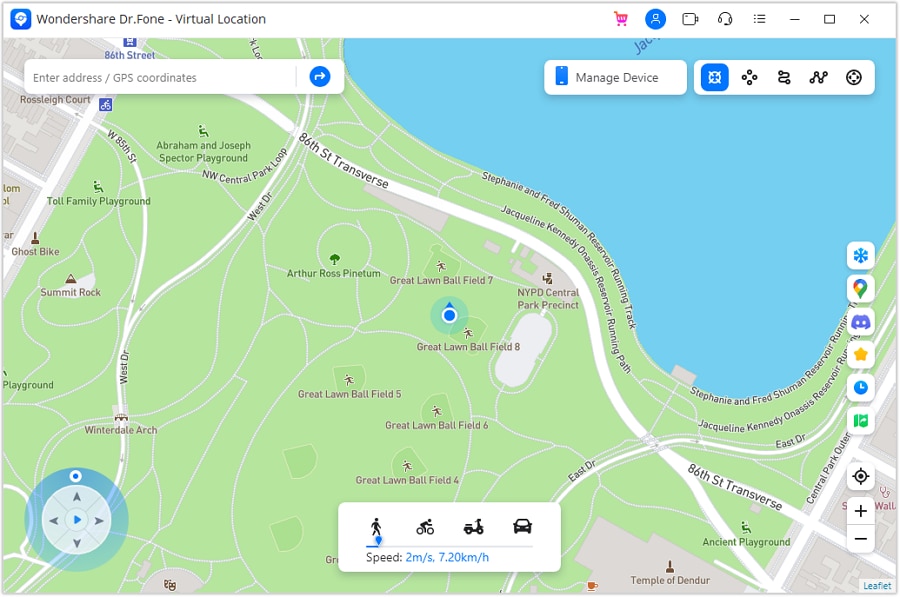
Step 3: Add the Desired Fake Location
Once the Teleport Mode is activated, add your desired location and press “Go.” Your desired location will open on the map. Select it, and a pop-up window will appear where you need to press “Move Here.” With that, your Android or iPhone’s Chrome location has been changed.
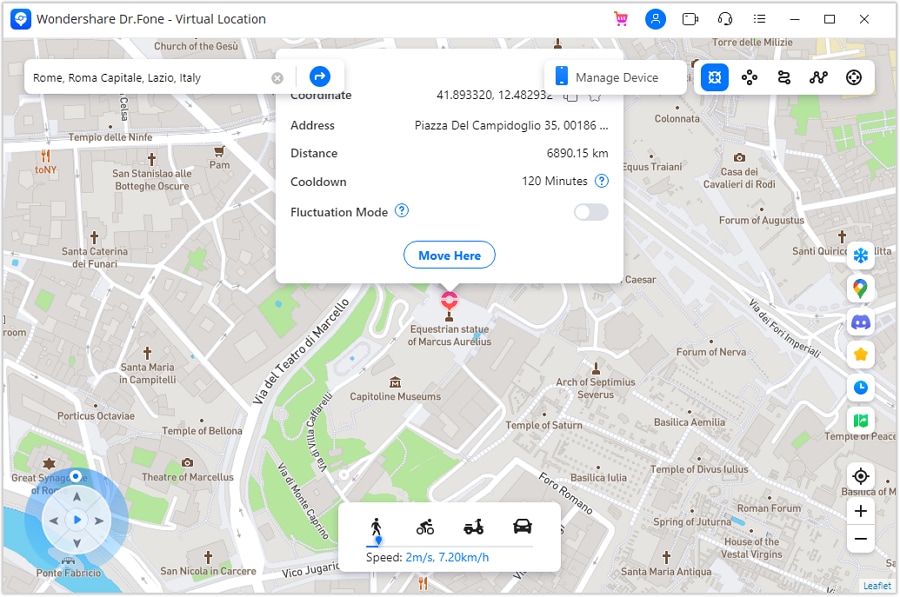
Method 2. Manually Change Your Location Using Google Chrome DevTools
It is also possible to fake browser location on Chrome using the Google Chrome Developer Tools. It is a built-in feature of Chrome and can be used to manually change or turn off your browser’s location. Follow these steps for changing location on Chrome with DevTools:
Step 1: After opening Google Chrome, click the three-dots icon from the top right corner. It will open the Chrome menu where you need to select “Developer Tools” after clicking “More Tools.”

Step 2: A window will open on the right side with all the developing tools you can use in Chrome. Click on the three-dots icon located near “Console” in the bottom left corner of the window. Choose “Sensors” from the pop-up menu.

Step 3: Access the newly selected “Sensor” option, and here you can change the browser’s location by either selecting a Google’s pre-set location or adding your desired location manually. Once the location is selected or added, your browser’s location will change.

Limitations
- The interface of the Google Chrome DevTools can be very confusing and overwhelming for non-technical users.
- Apart from pre-added locations, it can be hard to add a specific location as your fake location.
Method 3. Fake Your Location Using Chrome Extension
Many fake location Chrome extensions are available on Google Chrome which can be used to alter your location on Chrome. You can find these extensions on Google Chrome Web Store and add them directly to your browser. Below we have explained the steps for using such an extension “Location Guard “ to fake your location on Google Chrome:
Step 1: Open the “Location Guard” on Chrome Web Store and click “Add to Chrome” to add it to your browser. Once the “Location Guard” extension is added, open it and press “Options.”

Step 2: In the options, you can choose different options like Privacy Levels, Protection Area, and Time for Location Cache. It is recommended you choose a higher level for more protection.

Step 3: You can also use the “Fixed Location” feature to set up a fake location as a permanent location for your browser. The fixed location can be added by using the market or clicking on the desired place on the map.

Limitations
- Location Guard doesn’t protect your IP address. It means some websites can still detect your real location using the IP address.
- The app is not updated for quite a while, that’s why the map of the fixed location feature is quite restricted.
Method 4. Spoof Your IP Using a VPN Server
Another way you can fool websites and your browser by displaying a fake location online is to use a VPN server. VPNs fake your IP address to fool websites and apps into detecting your location. NordVPN is a VPN that can be used to spoof your IP by following these steps:
Step 1: Download and install NordVPN on your computer or phone and log in using your account. If you don’t have a NordVPN account, you must create one first.
Step 2: If you want to just change the location of your device, you can select “Quick Connect.” Using it will enable the program to automatically find the most suited fake location for you.

Step 3: You can also choose the desired location as your fake Chrome location in NordVPN. To do that, scroll down the list of countries and locations and choose your desired locations to connect to.
Limitations
- NordVPN can only spoof your IP address and will not work for geo-restricted applications.
- Using a VPN usually affects your internet speed and can make browsing slower and more difficult.
Part 4: FAQs
1.What is Geolocation?
Geolocation is a term used for the process of pinpointing the location of a device connected to the internet. The location can be determined using methods like IP address, GPS, and mobile tower data. Apps and websites commonly use it to provide location-based services.
2.What is the HTML5 Geolocation API?
The HTML5 Geolocation API is a browser API used to determine a user’s geographical location. Developers use it to build location-aware websites and apps that use users’ locations as the basis for providing their services. It can detect location through GPS, Wi-Fi, Bluetooth, IP addresses, etc.
3.Why should you hide or spoof your Location?
Hiding or spoofing your location protects your privacy and stop application and websites from tracking you. It also allows you to access geo-restricted apps and play location-based games. You can also fake your location to get the latest updates of your favorite apps.
Conclusion
The fact that Google Chrome in your devices can track your location with an accuracy of up to 20 meters is very unsettling for users. Even when you try to be careful in granting location permissions to apps and websites, many can still bypass this by adding location access requirements in terms and conditions.
That’s why having a tool like Dr.Fone - Virtual Location to fake GPS online is essential nowadays. It can ensure your privacy and helps in protecting you from the dangers of the internet.
Apply These Techniques to Improve How to Detect Fake GPS Location On Itel S23
GPS spoofing has become a common problem with companies because it often leads to inaccurate information. It can lead to costly errors and losses due to inaccurate GPS details. Hence, it’s important to learn how to detect fake GPS to ensure the accuracy and integrity of your data at all times.
In this article, we’ll show you how to apply clear and easy security measures to detect fake GPS locations. We’ll also use anti-fake GPS or other methods to prevent malicious actors from fooling your figures. Read below to learn more.
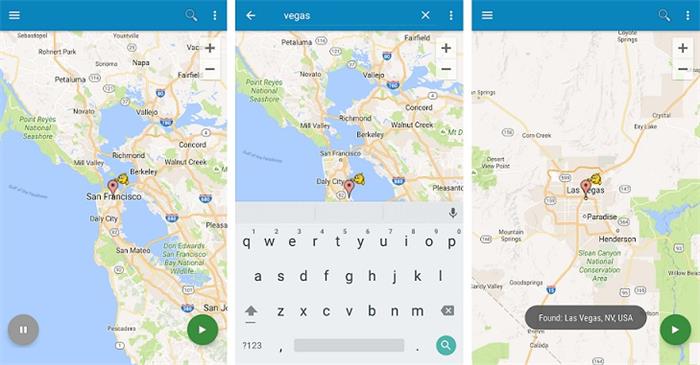
Part 1: What is Location Spoofing?
Location spoofing is a way for people to manipulate the location of GPS data shared by their devices. Faking your GPS is used for various actions, including accessing geo-blocked contents of an application, circumventing games or movies with country restrictions, or maintaining your privacy.
Using fake GPS software sends out false GPS signals from your device, hiding or changing your location. This sidesteps security as well as trust and safety terms of applications that rely on location signals.
Part 2: Ways to Fake Your GPS Location on Android and iOS
While most smartphones today have built-in methods to track your location, there are several ways to fake your GPS location, whether you’re using an iOS or Android. For whatever purpose you need to, you can download apps on the App Store or Google Play to hide your current location.
You can learn more about spoofing apps to prank your friends or play location-based games such as Pokemon Go to get more rewards.

Try to find a reliable spoofing app? The good news for you is that there is a powerful tool, Wondershare Dr.Fone – Virtual Location , which allows a one-click process to effortlessly spoof your GPS location to any destination for enhanced enjoyment in AR games.
This versatile tool effortlessly integrates with popular location-based apps such as Pokémon GO, Snapchat, Instagram, and more. Take control with the ability to simulate GPS movement along a route you draw. You can use its joystick feature to flexibly mimic GPS. It is fully compatible with the latest operating systems, supporting Android 14 and iOS 17.
Noteworthy Aspects Wondershare Dr.Fone - Virtual Location
- Wondershare Dr.Fone can maintain a record of all the routes you follow and the locations you visit to ensure you can always access them again.
- This location spoofer contains features such as a one-stop route and multi-stop route to help you mimic realistic movement when playing AR games.
- To ensure you are able to spoof your location and movement, Wondershare Dr.Fone allows you to choose between walking speed and driving speed.
Steps for Faking Your GPS Location via Wondershare Dr.Fone - Virtual Location
Spoofing your location becomes effortlessly achievable through Dr.Fone - Virtual Location. This has to do with its innovative algorithms and thanks to its user-friendly approach. The process of faking the location involves the following steps:
Step 1: Access Dr.Fone - Virtual Location and Move to Toolbox
Begin with the launch of Dr.Fone - Virtual Location on your computer and establish a connection with your Android or iOS device. Navigate to the map screen and select the “Teleport Mode” icon, which is situated as the first option in the toolbar near the top-right corner. Now, start the process by tapping the search bar at the top left corner, inputting your desired location, and hitting “Enter.”
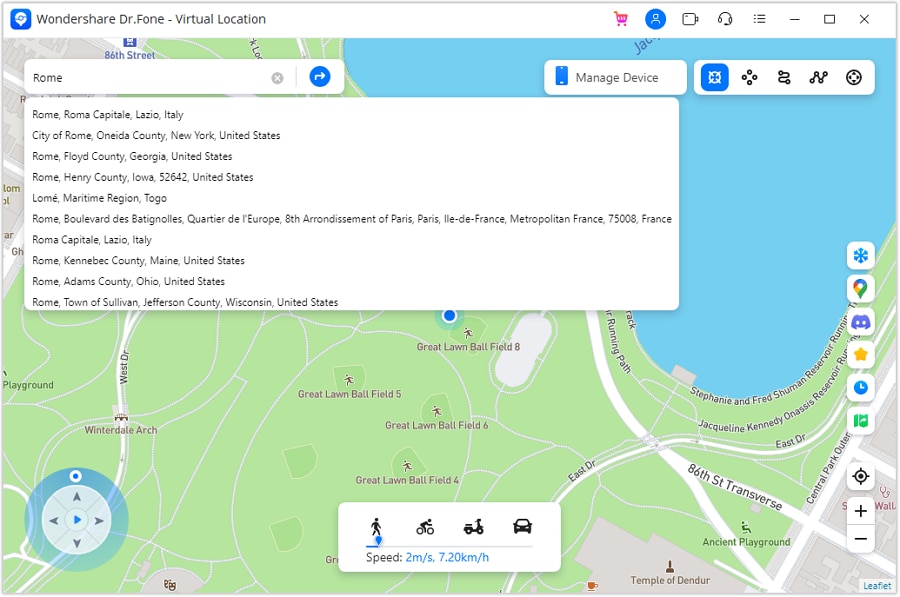
Step 2: Move to the Targeted Location and Verify It
Upon completion of the initial setup, proceed to teleport to the targeted location by clicking “Move Here” on the map screen. This action prompts the cursor to relocate to the specified location on the map. It also simultaneously adjusts the location of your Android or iOS device. To validate the successful location change, access your smartphone and open a map application.

Part 3: Why is GPS Spoofing a Problem?
Faking your GPS has its advantages, primarily protecting your privacy.
However, if you’re on the receiving end of a fake GPS signal, you need to detect any spoofing attempts before it’s too late. You need to have a security measure to ensure data you’re receiving is coming from a legitimate source instead of a malicious one. It is especially important for large companies engaging in food delivery, gaming, social media, financial services, etc.
Here are some reasons why your company should be wary of GPS spoofing.
Food Delivery
Couriers who use GPS spoofing can trick food delivery apps into allowing them to accept orders they otherwise would not have access to. They may also gain an unfair advantage to gain priority in order queues and report longer rides to earn more from the platform. In addition, a more egregious issue is couriers charging for deliveries that weren’t made.

Gaming
Using GPS spoofing in MMORPGs enables gamers to take advantage of faking their position without moving into the comforts of their own home. This can lead to more in-game rewards that are otherwise difficult to achieve without GPS spoofing.
Location spoofing also allows cheaters to use hundreds of mobile devices to collude and share in-game information to scam other players.
Social Media
Having a fake GPS on dating apps allows users to unlock more users on their profile to match with in other places. It can be dangerous if scammers or fraudsters use fake GPS to trick people into concealing their actual location.
Financial Services
Most financial institutions across the globe use location data to verify users to prevent fraud. Having inaccurate data is a major security beach, especially when handling financial service apps on the internet.
There are various ways to protect yourself from being on the other end of a fake GPS location. You can easily use specialized apps, including mock location detection APKs if you’re on Android. These anti-spoofing GPS apps help detect if someone is providing fake GPS locations. However, if this is not available to you, there are several ways you can mitigate malicious actors by applying some safeguards.

Here are some of the methods you can take advantage of.
- Cross-reference location data from multiple sources to detect fake GPS locations. You can cross reference from GPS, Wi-Fi, and cell tower triangulation to analyze accurate GPS.
- Analyze abnormal patterns in location data presented to you from sudden jumps in location or having unrealistic speeds during movement.
- Verify the accuracy of GPS by comparing location data to known landmarks, including buildings, bridges, or roads.
- Using a dedicated GPS simulator and comparing results to expected from provided data.
- Have a security measure to detect GPS spoofing apps installed on a user’s smartphone.
While the methods to detect GPS locations are presented above, it’s important to remember that detecting fake GPS locations is difficult and requires you to combine different methods. You can easily detect mock locations on Android, but the methods available if you’re on a different device will vary depending on the resources at your disposal.
Conclusion
Faking your GPS is easy nowadays. You can download an application and tinker with a few settings on your smartphone to start GPS spoofing. For secure virtual navigation, make Dr.Fone - Virtual Location your first choice. As a result, anti-spoofing in GPS is are the rise, especially if you’re on the receiving end of the data.
Knowing the telltale signs of a fake GPS is a must to ensure you will not be deceived when transacting online. In the end, the most effective way to detect if someone is faking their GPS is by checking if their smartphone has a GPS spoofing app.
How to Share Location in Messenger On Itel S23?
We usually host a gathering once in a while and invite our friends to come over. Most of us are already used to organizing such activities because we’ve been doing that for a long time now. However, we cannot deny that it’s much easier nowadays than years ago. Why so? Simply because the communication channels available today at our disposal are more digital and more capable. For instance, Facebook Messenger now allows users to share their whereabouts in a snap of a finger. Yes. That feature is called Live Location.
The Live Location feature on Messenger works beyond sending the address or coordinates of your exact location. It basically visualizes your whereabouts by means of an interactive map and updates the details from time to time. That means the receiver can view not only your position but also your movements. Is that helpful? Absolutely yes. It’s indeed a game-changer in today’s already convenient world. Is it highly recommended? With proper handling and adequate caution, Messenger’s Live Location can definitely do more good than harm to the users.
In this article, we will delve into the highlights and benefits of Facebook Messenger’s location-sharing features. We will also provide some tutorials on how to share Live Location on Messenger. Continue reading below to learn more.
Part 1. Everything You Should Know About Messenger’s Live Location
Facebook is well aware that sharing location details is essential to its users. That’s why developers have come up with a brilliant idea and rolled out Live Location on Messenger. It basically works like other location-sharing features. However, Live Location provides more precise and thorough location information. It’s in map form, where you can view the exact location and track the movements of the sender. You’ll continue to see updates for as long as the sharing is not halted on the other end. To navigate it properly, try to read tutorials on how to share Live Location on Messenger.

What if you wish to send a particular address from another location? There is no problem with that. Messenger allows users to search for a specific place, trace it on the map, and share the details. The receiver can view it in map form and get directions if necessary. See? It’s very easy and convenient. No need to type in long addresses just to share a particular location with your friend. You just have to find it precisely on the map and send the information afterward.
Convenience is just one thing. Messenger’s location-sharing feature has a lot more to offer to users. One of which is the accuracy of the shared location information. Since the details are automatically generated through GPS, you can be sure that it is correct and definite. If you go out and track it down the neighborhood, you can certainly find the location in no time. Just make sure that the location services on your smartphone are activated so you can view your progress in real time. Also, stay vigilant while you’re out and keep yourself safe from any harm. Remember that safety remains a priority and comes above convenience.
How to Grant Facebook Messenger the Permission to Access Your Location?
Facebook Messenger’s location-sharing feature will not work without the necessary access. That’s why you should first configure the permission settings on your mobile device to avoid unwanted disruptions. Don’t worry. It’s indeed a piece of cake. Check out the tutorial provided below.
- 1: Go to Settings.
- Step 2: Click Apps.

- Step 3: Find and click Messenger.

- Step 4: Click Permissions.

- Step 5: Click Location.

- Step 6: Select Allow Only While Using the App. If you’re quite conservative regarding this matter, click Ask Every Time instead. After that, Facebook Messenger will have access to your location information.

Part 2. How to Share My Location on Messenger?
How do I share my location on Messenger? As mentioned earlier, it’s very easy to use Facebook Messenger for location sharing. All it takes is just a few clicks on the platform. No need to manually type in the address or sketch the landmarks. Messenger does the rest of the work for you. In actuality, there are three ways to share your location on Messenger. Any of them can be of great help to you, depending on your current situation. Do you want to try them now? Check out the tutorials below.
Method 1: Share location on Facebook Messenger via Live Location
How to share my location on Messenger? Well, the first option you can try is through Live Location. It works best if you wish to tell somebody where exactly you are and give updates from time to time. Don’t worry. Although it looks complicated at a glance, in reality, it’s actually not rocket science. It only takes a few seconds to complete. Below is a tutorial on how to share Live Location on Messenger in easy steps.
- Step 1: Open the Facebook Messenger application on your mobile device.
- Step 2: Browse through your conversation feed and find the contact with whom you wish to share your Live Location. Click on it.
- Step 3: Click the More (+) icon at the bottom-left corner of the screen.

- Step 4: Right after, click Location.

- Step 5: Click Start Sharing Live Location. Immediately, your current location details will be available and forwarded to the intended receiver. Live Location lasts for 60 minutes at maximum. If you wish to terminate it, simply click Stop Sharing Live Location.

Method 2: Share location on Facebook Messenger via Pinned Location
Let’s say there is a specific place you want to visit with your friend. Is there a way to share the address of the venue without you being there at the moment? Fortunately, it is possible. Apart from sharing your current location in real-time via Live Location, you can also send pinned locations on Messenger. You just need to search for it and then redirect the details to your friend. Yes. It’s just as simple as that. Do you want to try it on your smartphone? If so, follow the guide below.
- Step 1: Launch the Facebook Messenger application on your mobile device.
- Step 2: Scroll through your conversations and find the receiver from the list. Click on it.
- Step 3: On the text field, click the More (+) icon at the bottom-left corner.
- Step 4: Then, click Location.
- Step 5: Locate the search bar above the interactive map and type in the location you want to share.

- Step 6: Choose one from the suggested results and then click on it. The details will then be forwarded immediately to the intended receiver.
Method 3: Share location on Facebook Messenger via Google Maps location
How do I share my location in Messenger if I cannot find it on the map provided? Yes. That happens sometimes. There are certain places that are untraceable on the messaging platform. As a result, it doesn’t appear on the map when you try to search for it. But don’t sweat it. If you experience the same issue, you can instead use Google Maps to share location details. How to do it? Check out the tutorial provided below.
- Step 1: Launch the Google Maps application on your mobile device.
- Step 2: Click on the Search bar at the top and then type in the location.

- Step 3: Choose one from the suggestions and then tap on it. Make sure that it is exactly what you’re looking for.

- Step 4: Access the menu bar below the map and then click Share.

- Step 5: From there, click Chats or the Facebook Messenger logo.
- Step 6: Find the receiver from the provided list and then click the Send button next to its name.

NOTE: Of course, you can only send pinned locations via Google Maps. The Facebook Messenger’s Live Location is available within the platform only.
BONUS TIP: Protect Your Privacy With Wondershare Dr.Fone
There’s no denying that the location-sharing feature of Facebook Messenger is useful to many of us. It always comes in very handy whenever we need to meet people somewhere or invite them to our places. However, we should not become too complacent and let our guard down. Sharing sensitive information like whereabouts always comes with risk, regardless of the platform and the intention. Therefore, make it a habit to protect your privacy at all costs. In this regard, Wondershare Dr.Fone has something special to offer. Its Virtual Location feature, capable of modifying and simulating your location records, can be of great help for you. Don’t worry. It’s very easy to use. Here’s a short guide for you.
- Step 1: Download Wondershare Dr.Fone from its official website. Right after, install it on your computer.
- Step 2: Launch the newly installed software on your desktop. Once it fully loads up, connect your smartphone using a data cable. Follow the on-screen instructions and perform the steps accordingly to ensure the connection between the two devices is stable enough to handle the succeeding operations.
- Step 3: Navigate to the left-side panel and then click Toolbox. On the main dashboard, click Virtual Location. Is it your first time using this feature? If so, allow Wondershare Dr.Fone to download additional resources. Don’t sweat it. It will only take a few minutes to complete.
- Step 4: Once the downloading process has concluded, Wondershare Dr.Fone - Virtual Location will automatically open on a separate window. From there, go to the top-right menu bar and then click Teleport Mode. It is the first icon that appears in the row.

- Step 5: Head over to the top-left corner and enter your desired location into the search bar. Choose one from the suggested results. After that, click the Enter icon.

- Step 6: The details regarding your chosen location will be displayed on the computer screen. Review the information and make sure that it is the specific location you’re looking for. Once confirmed, click Move Here to proceed.

- Step 7: Immediately, the location settings on your smartphone will be changed according to the inputs you have provided to Wondershare Dr.Fone. You can verify it by checking the current location registered on your Maps app. After confirming that your mobile device is now showing a different location, you can now start browsing without worrying about your location’s privacy.
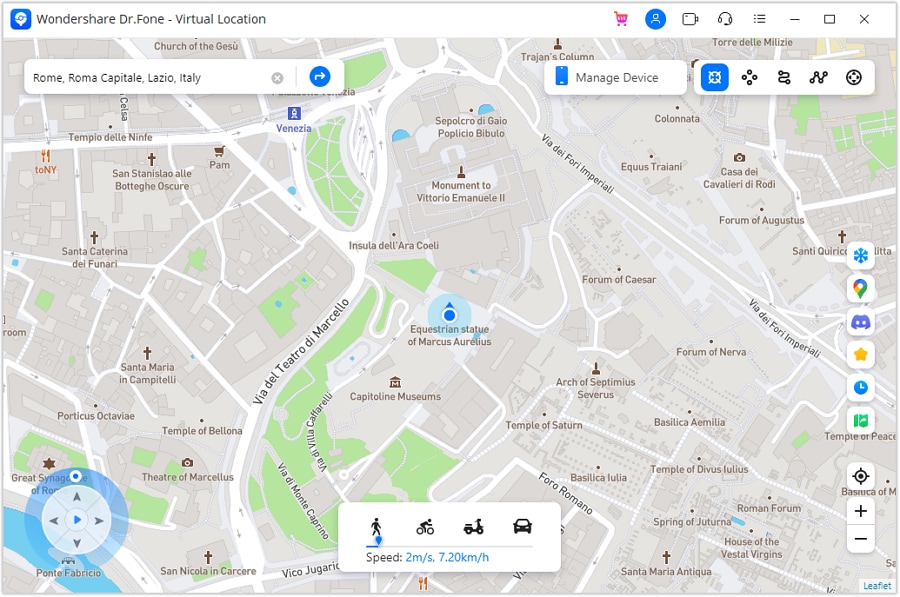
NOTE: Resort to Wondershare Dr.Fone - Virtual Location if your internet browsing does not require you to provide your real address. If you wish to restore your original location settings, simply close the Wondershare Dr.Fone application and restart your smartphone.
Conclusion
Gone are the days when you had to write invitation cards manually and deliver them one by one. Nowadays, all you need to do is go online and use Messenger’s location-sharing feature. Have you already tried it? If not, you should take it into consideration and use it on your next agenda. Refer to the tutorial above on how to share Live Location on Messenger. It can certainly help you get started. How do I share my location on Messenger without physically being there? That’s simple. Use Messenger or Google Maps’s pinned location. Furthermore, download Wondershare Dr.Fone on your computer. Its Virtual Location feature, capable of modifying your location settings, can provide protection for your privacy. Just connect your Itel S23 to the computer and set it up from there.
Also read:
- [New] Navigate Easy Customization for YouTube Channel URLs
- [Updated] 2024 Approved The Ultimate Mix of YouTube & Instagram Feeds
- [Updated] Efficient Methods to Master Your Phone Memos
- [Updated] Twitter's Top 10 Viral TikToks Uncovered
- 5 Hassle-Free Solutions to Fake Location on Find My Friends Of Honor 100 Pro | Dr.fone
- Apply These Techniques to Improve How to Detect Fake GPS Location On Oppo A38 | Dr.fone
- Discovering the Varieties in Non-Contact Technology
- Fixing Foneazy MockGo Not Working On Vivo Y100 5G | Dr.fone
- How To Fake GPS On Oppo Reno 11 Pro 5G For Mobile Legends? | Dr.fone
- How to Find iSpoofer Pro Activation Key On Itel A60s? | Dr.fone
- In 2024, Personalize Your Screen Time with These Top 6 Creator-Identifying Questions
- Planning to Use a Pokemon Go Joystick on Honor X8b? | Dr.fone
- Seamless ScanSnap Driver Setup and Update Tutorial for Windows Users
- Which is the Best Fake GPS Joystick App On Xiaomi Redmi K70? | Dr.fone
- Title: How to Stop Google Chrome from Tracking Your Location On Itel S23? | Dr.fone
- Author: Ava
- Created at : 2024-11-08 17:22:59
- Updated at : 2024-11-12 16:39:30
- Link: https://fake-location.techidaily.com/how-to-stop-google-chrome-from-tracking-your-location-on-itel-s23-drfone-by-drfone-virtual-android/
- License: This work is licensed under CC BY-NC-SA 4.0.